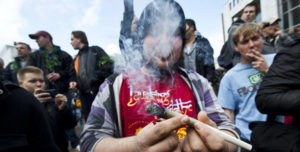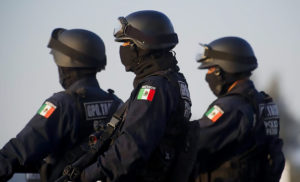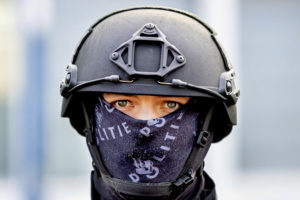Antwerp
Antwerp harbour leads up the River Scheldt and into the heart of Europe, a port the size of 16,600 football fields, sucking in 240,000,000 tonnes of freight each year. From the giant aerial photograph spread out on the floor of the Port Authority Building, you can see the open sprawl of its spreading fingers and multiple roads. But it’s not just bananas, steel and new cars that are unloaded here. Antwerp is now Europe’s main artery for cocaine smugglers, and the attendant violence they bring with them.
The increase in violent crime is, according to the Antwerp Federal Police, impossible to ignore. Last year, they confiscated €20.7 million in cash and goods and started 94 investigations into drug-related violence. Intercepted cocaine in Rotterdam harbour, in the Netherlands, dropped from almost 73,000 kgs in the record year of 2021 to under 47,000. Meanwhile finds in Antwerp have increased to a peak of almost 110,000 kgs. Antwerp is now, say customs officers, “the top destination for criminals”, and established Dutch drug gangs are spilling over the Belgian border. Last autumn, four Dutch suspects were arrested for allegedly preparing a kidnapping attempt on the Belgian justice minister Vincent van Quickenborne, who went into hiding following a summer of grenade attacks linked to Dutch and Belgian criminal gangs. In Antwerp this January, 11-year-old Firdaous EJ, the niece of an alleged Belgian druglord, was shot dead in a drive-by attack on her home.
“It’s a narco-state lite,” says Teun Voeten, a photographer and the author of several books on the drug trade, who lives in Antwerp. He was first made aware of the problem of drug violence by the sound of hand grenades on his street in Deurne in 2018, an attack which damaged 16 cars and 10 houses. “The Amsterdammers were always the big bosses, but with the cracking of EncroChat and Sky ECC, some gang leaders have been arrested. Now the Antwerp families are going for themselves, and every change is marked with violence.” It is something Antwerp mayor Bart de Wever has warned about repeatedly: vergismoorden, collateral murders of civilians, which are rife in the Dutch criminal world. Now he says it is a “national crisis”. Last month, Belgian prime minister Alexander De Croo announced €17 million a year for a new harbour police force, more scanners, screening for 16,000 personnel in “sensitive” positions, and international efforts, including a deal with five shipping companies and the Dutch.
“Belgium has a problem because of its proximity to the Netherlands,” says Andrew Cunningham, drugs market and crime lead at the European Monitoring Centre for Drugs and Drug Addiction (EMCDDA). “Rotterdam was seizing big hauls of cocaine a few years ago, the Dutch really improved port security, then there’s this waterbed effect: the criminals move to Antwerp to bring in the cocaine. Antwerp is a huge, sprawling port and it’s very difficult to control.” Around five years ago, police and prosecutors feared crime was leaching from the Dutch underworld into Belgium. But when academics including Charlotte Colman, professor of criminology at the University of Ghent, investigated the matter, they didn’t find a displacement, but an expansion of both the drug market and the Belgian and Dutch criminal networks.
Historically, when there was a Low Countries frontier at all, the Dutch-Belgian border was always leaky. The Fifties and Sixties saw a “bitter battle” for customs officers when Dutch gangs began smuggling butter southwards. The Dutch, who had commercialised margarine, weren’t bothered about what they spread — but the Belgians demanded butter, which cost twice as much. Stuffing it into the back of American trucks, armed butter smugglers traded it over the border until it was no longer profitable. Then came the illegal drugs. By 2015, a peninsula in the River Maas had become a top crossing point for drug smugglers. It was impossible to police, so Belgium gave it back to the Netherlands.
The criminals here speak the same language and exploit the free travel. “It’s a historical thing, that Belgium and the Netherlands work together, and they misuse the border,” says Prof Colman. “For example, in the case of synthetic drug production, you have the drug production facility in Belgium and then the dumping in the Netherlands… The border between Belgium and the Netherlands is a bottleneck for criminal justice, and an opportunity to be invisible and expand territory for the criminal organisation.” When one of her research team went into prisons to interview people convicted of producing or smuggling drugs, they said they saw Antwerp and Rotterdam “as one port” — all that mattered was which contacts they had on the inside. So when Rotterdam increased fines last year for people trespassing in the harbour to collect drugs hidden in shipping containers, the smugglers could easily shift to Antwerp. “The criminal organisations also take advantage of the difference in jurisdictions,” points out Joris van der Aa, crime reporter for the Gazet van Antwerpen.
Researchers believe most of the cocaine coming to Belgium goes to the Netherlands, and police hacks of “secure” messaging services — key to arresting suspects Ridouan Taghi and Saïd Razzouki in the ongoing Dutch Marengo gang trial — have revealed the inner workings of this relationship. “Initially with the Belgian-Dutch criminal networks, the [Dutch] were mostly involved in the higher level: logistics, the financial organisation,” says Prof Colman. “But today we notice that Belgians have gone up the chain, including controlling and organising the smuggling. They are not only working for Dutch people: Dutch people could be working for them as well. We see an expansion in the criminal networks, and we also see a kind of shift with people from Belgium picking up the lead role as well.”
The cocaine trade is particularly streamlined, and the European market price of €50 a gram remains stable despite the amounts intercepted. Cunningham at the EMCDDA says: “When I ask law enforcement what they think the interception rate is, sometimes they say 10%, sometimes they say 25%.” Even if 40% were intercepted, it may still be worthwhile for criminals — like self-service tills in supermarkets, which accept a certain level of theft as “shrinkage” in exchange for lower staff costs. This is also a story, after all, about trade: a battle between the trade of the criminals supplying European demand for drugs, and “legitimate businesses” whose infrastructure networks they piggyback. When a company’s ships bring perishable goods to a new harbour like Vlissingen instead of Antwerp, says Van der Aa, the cocaine follows.
On the flip side, harbour companies and shipping businesses know that if — as Rotterdam mayor Ahmed Aboutaleb wants — they scan every fruit container, this costs time and money, making them less competitive. When I asked the five shipping firms that signed an accord with the Belgian and Dutch governments last month about this — Hapag-Lloyd in Germany, MSC in Switzerland, Seatrade Group Rotterdam, CMA-CGM in France and Maersk in Denmark — there was some reticence.
Menno van Gorcum, director of Seatrade Group Rotterdam, is glad of joint action. “It had reached a level where something had to be done, and fortunately there is sufficient political attention to this,” he says. “We just keep on doing what we have been doing.” Hapag-Lloyd stresses that it is a team game and agrees that nobody wants to be less competitive than other firms — or to tell the criminals how to get around the new measures. The puzzling thing, though, is why criminal gangs are now so openly violent, when this draws attention to their activities and forces politicians to invest more in policing. Voeten, whose book on the crystal meth trade is being translated into English later this year, believes it is down to cocky amateurism. “A good gangster is an ultra-capitalist,” he points out. “You use violence now and then, but the imminent threat of violence works better than violence itself.”
While violent crime in general has decreased across Europe, in the context of drug-related criminality, it has remained stable or increased, according to the EMCDDA. Cunningham ascribes this to the rivalries between many groups “all vying for a slice of the lucrative cocaine market”. The increase in Belgium is undeniable since 2012, with the first known case related to a rip-off deal. Now experts see violent crime used as intimidation and punishment, but also a tactic, so that police will investigate a competitor. We also know more about “invisible” violence, including the construction of an underground prison equipped with a gruesome torture chamber in the Netherlands.
Elsewhere, the contrasting approach of the Belgian and Dutch governments is starker. While the Belgian prime minster and the mayor of Antwerp are talking about cracking down — including on drug users — the Dutch will start a trial of regulated cannabis growing in the south this October, and Germany plans to legalise and control the drug. “Let’s be realistic: it’s impossible to make a fortress of our ports,” says Van der Aa. “The federal police is short 150 detectives. Trying to stop the cocaine is cat and mouse play, but the criminals are still there. You have to stop them — and that is not happening in Belgium.”
Disclaimer
Some of the posts we share are controversial and we do not necessarily agree with them in the whole extend. Sometimes we agree with the content or part of it but we do not agree with the narration or language. Nevertheless we find them somehow interesting, valuable and/or informative or we share them, because we strongly believe in freedom of speech, free press and journalism. We strongly encourage you to have a critical approach to all the content, do your own research and analysis to build your own opinion.
We would be glad to have your feedback.
Source: UnHerd Read the original article here: https://unherd.com/




